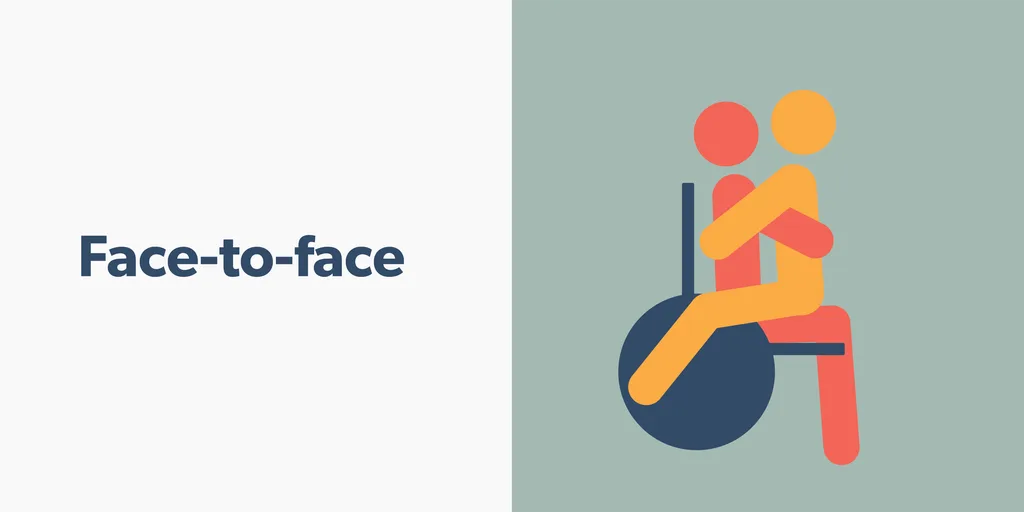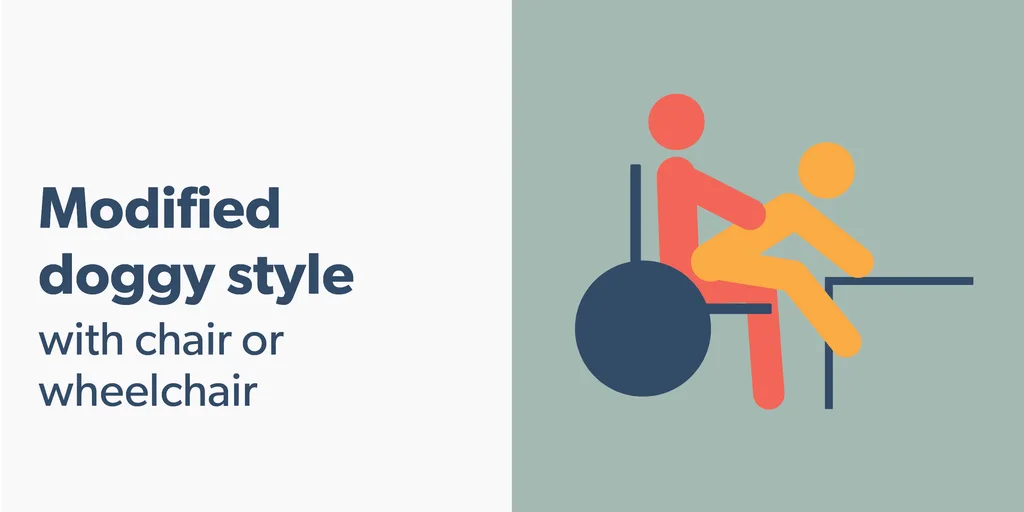Here's what we'll cover
Sex is an essential and healthy activity for almost everyone, including people with disabilities.
There are many questions (and misconceptions) floating around about sex and disabilities, but no matter if your disability is due to age, injury, or another condition, there are plenty of ways to enjoy a healthy and satisfying sex life.
Here’s a closer look at some myths about disabled sex positions, as well as our top tips for having great sex with any type of disability.
Misconceptions surrounding sex and disabilities
Because societal views of sex are predominantly normative, people with disabilities and seniors are often unfairly viewed as asexual or non-sexual. If someone has sex in a way that’s not considered “normal,” many just assume (or ignore) that sex doesn’t happen at all (Shah, 2017).
This problematic assumption creates barriers, making it harder for people to form fulfilling sexual partnerships. (Carew, 2017). Many healthcare providers also fail to address sexual issues in people with disabilities, making them less inclined to ask about it (Holdsworth, 2018).
Why does that matter? There are over 61 million people in the United States living with some type of disability, and each deserves the right to healthy sexual relationships. Not only is sex important for developing strong relationships, but it can also have positive effects on overall health (Okoro, 2016).
Education and exposure to the idea of differently-abled people having sex could help address such misconceptions. Because many people have had little to no exposure to this, they have a narrow understanding of the topic. Developing comprehensive sex education curriculums in schools and seeing more about sex and disabilities in the media are a few ways we can be more disability-inclusive.
The benefits of sex for your health
Besides feeling good, sex provides a number of benefits to both our mental and physical health, which we’ll take a look at below.
Sex is a form of exercise
Sexual activity can serve as moderate to significant exercise for healthy couples. Though probably not enough cardio activity on its own, sex has been found to burn an average of 3.6 calories per minute for couples engaging in their natural environment.
Sex is an excellent addition to other physical exercises to help strengthen muscles, reduce blood pressure, and increase heart health (Frappier, 2016).
Sex improves how quickly we overcome stress
When we’re under physical or psychological stress, our bodies release a hormone called cortisol.
Researchers examined the cortisol levels of stressed adults during nonverbal acts of intimacy, such as snuggling, cuddling, and handholding. They discovered that couples who experienced this type of intimacy showed a faster recovery compared to less affectionate couples (Ditzen, 2019).
So if you’re having a bad day, cuddling with a partner may make you feel better faster.
Sex may reduce the risk of prostate cancer
One study followed more than 30,000 men over nearly 20 years to evaluate if men’s sexual habits could affect the rate of prostate cancer diagnoses.
Researchers found those who reported at least 21 ejaculations per month (whether partnered or alone) were less likely to be diagnosed with prostate cancer in later years compared to men who reported 4-7 ejaculations per month (Rider, 2016).
While scientists can’t definitively link a lower risk of prostate cancer to more frequent ejaculations, sex may be a fun way to keep your risk low.
Physical vs. mental disabilities and sex
Physical disabilities make up the largest portion of the more than 25% of American adults living with a disability (Okoro, 2016).
There are many things that can lead to physical disabilities that may affect your sex life. Some of the most common include direct trauma to the genital area from either accident or disease, damage to your nervous system (like from a stroke or spinal cord injury), and congenital conditions (Glass, 1999).
Those with physical disabilities may wonder about some of the basics of sexual activities. Especially if it’s the first time, they may wonder how to move their body to a comfortable position or what to do with their medical equipment if they have any.
Don’t be afraid to talk to a healthcare provider about these issues. These questions need to be answered, and answers may differ depending on your disability (CSCM, 2010).
For example, someone with a spinal cord injury may need to be careful to avoid injuring their spinal cord further, and may need to try out sex positions for limited mobility. Alternatively, someone lacking sensation below the waist may need to avoid certain positions to avoid inadvertently injuring themselves during sex and (CSCM, 2010).
Other common difficulties you may face are trouble with sexual desire, arousal, orgasm, vaginal lubrication, sexual pain, or erectile dysfunction (CSCM, 2010).
People with mental disabilities can also have problems involving sexual health and wellness, regardless of the actual physics of sex.. Multiple studies have shown those living with a mental disability are more likely to report being the victim of coerced or forced sexual experiences (Holdsworth, 2018).
Safe sex and disabilities
All people who practice unsafe sex are at risk for developing a sexually transmitted infection (STI) like HIV, AIDS, genital herpes, and more.
Studies report that those with mental disabilities are more likely to have unsafe sex compared to people without cognitive disabilities. In some cases, up to 50% or more of their sexual encounters were considered unsafe, increasing their risk of developing STIs. Some possible risk factors for unsafe sex include a higher rate of socioeconomic disadvantages amongst those with mental disabilities compared to those without, a higher rate of coerced or forced sexual encounters, and the inability of some sexual health clinics to provide adequate care to those with mental disabilites (Baines, 2018).
People who use wheelchairs or engage in wheelchair sex positions need to take care to prevent slipping out of the chair, tipping it, or some other type of accident. If you have physical limitations, talk to a healthcare provider before engaging in sexual activities to about learn about any physical precautions you should to take.
7 sex positions for people with disabilities
Just because someone has limited mobility doesn’t mean they can’t have great sex. Here are seven sexual positions to try for different types of disabilities (Spinal Cord Injury BC, 2019):
1. Modified Missionary
This position leaves the bottom partner’s hands free to explore the standing partner’s erogenous zones.

Instructions:
The partner with limited mobility lays on the bed with their butt on the edge.
The other partner stands between their legs, facing the bed.
The standing partner lifts their partner’s legs so their ankles are resting on their shoulders.
Alternatively, the partner with limited mobility can rest their legs on a chair behind the standing partner.
Who benefits?
Couples in which one person has limited mobility and the other doesn’t
If either or both partners have obesity
People with an ostomy bag (a pouch affixed to the abdomen to collect stool, often needed after certain bowel surgeries)
Pregnant women
2. Face-to-face
This position allows for face-to-face intimacy.

Instructions:
The partner with limited mobility sits in a chair, a wheelchair with armrests removed, or on the edge of the bed.
Their partner straddles them and wraps their arms around them.
The partner on top braces their feet on the edge of the bed to thrust.
The partner on the bed can assist by grabbing their partner’s buttocks and lifting and bouncing.
Who benefits?
People with limited mobility
People who have muscle spasms when lying down
People with chronic fatigue
3. Intimate sitting3. Intimate sitting
This position gives control to the top partner if the other has limited mobility.

Instructions:
The partner with limited mobility sits on the bed with their legs outstretched. Placing pillows behind your back or resting against the headboard may make this position more comfortable.
The other partner straddles their waist, puts their feet on the bed, and then bends their knees to lower down.
Who benefits?
Those looking for face-to-face intimacy
Couples in which one partner has limited mobility and the other does not
4. Spooning or side-lying
This position allows both partners to have their hands free to stimulate other areas. Spooning is great for people with conditions like arthritis as it’s low movement, and the bed absorbs pressure on the joints.

Instructions:
Both partners lay on their sides facing the same direction.
Alternatively, one partner can wrap their top leg over the other partner’s thigh to help support each other in the position.
Who benefits?
Pregnant women
If either or both partners have obesity
People with lower back pain, arthritis, and chronic pain
5. Modified doggy-style position #1
This position is helpful if using a wheelchair and more comfortable for those with joint pain.

Instructions:
The partner with limited mobility moves their wheelchair to the edge of the bed or sits in a chair.
The other partner lowers themselves on top of the bottom partner so their back faces the other partner’s stomach.
The person on top rests their arms and upper body on the bed while thrusting.
Who benefits?
One wheelchair-bound partner and one partner without disability
People with hip pain,
6. Modified doggy-style position #2
This position allows for a head-to-toe physical connection.

Instructions:
Arrange a few pillows on the floor or bed to support the partner with limited mobility.
The other partner lies on top, with their chest against the back of the lower partner.
Who benefits?
People who require more stability as the bottom partner
7. Sideways 69
This position leaves both people are free to stimulate each other with their fingers, tongue, or sex toys.

Instructions:
One partner lays on their side in the spooning position.
The other partner lays facing them with their head at the opposite end.
Who benefits?
People with weak or spastic hips
People with arthritis or fragile joints
Sex toys, foreplay, and devices
All of these disabled sex positions focus on penetrative sex, but there are plenty of other ways to take advantage of everything our bodies have to offer. After all, sex is more than just the act of penetration—there can be an intense emotional and physical connection between partners.
If you have trouble with some of the physical aspects of sex, remember that you can use your other senses to enjoy the experience, especially during foreplay (CSCM, 2010). Sound, sight, smell, touch, and taste can augment the sexual experience turning good sex into great sex.
Our bodies are full of extra sensitive areas called erogenous zones, which can offer plenty of thrills and shivers when touched in just the right way. Some of the more popular erogenous zones include the ears, neck, and inner thighs.
Foreplay is one of the easiest ways to spice things up, regardless of physical limitations. Remember, all of your senses can take part. Sensual massage oil, aromatic candles, ice cubes, and all sorts of other things can help spice up your sex life.
Take time to appreciate each other’s bodies by touching, kissing, stroking, and massaging—then see how things heat up. Going slow can be a considerable benefit during foreplay, and physical limitations usually aren’t a factor.
In addition to foreplay, oral sex is always a fantastic alternative to penetrative sex. We already covered the classic “69” position, but oral sex can happen pretty much anywhere. People in wheelchairs can give their partners oral sex by having them lay on the edge of the bed, kitchen table, couch, bathtub, or wherever the mood strikes.
Lastly, devices may also help improve sexual health. Both men and women may benefit from vibrators to enhance their arousal and sexual experience. For men with erection difficulties, there is a range of therapies available that you can discuss with a healthcare provider. Medications, penis pumps, injections, and penile implants may help (CSCM, 2010).
DISCLAIMER
If you have any medical questions or concerns, please talk to your healthcare provider. The articles on Health Guide are underpinned by peer-reviewed research and information drawn from medical societies and governmental agencies. However, they are not a substitute for professional medical advice, diagnosis, or treatment.
References
Baines, S., Emerson, E., Robertson, J., & Hatton, C. (2018). Sexual activity and sexual health among young adults with and without mild/moderate intellectual disability. BMC Public Health, 18 (1), 667. doi: 10.1186/s12889-018-5572-9. Retrieved from https://pubmed.ncbi.nlm.nih.gov/29843657/
Carew, M. T., Braathen, S. H., Swartz, L., Hunt, X., & Rohleder, P. (2017). The sexual lives of people with disabilities within low- and middle-income countries: a scoping study of studies published in English. Global Health Action, 10 (1), 1337342. doi: 10.1080/16549716.2017.1337342. Retrieved from https://pubmed.ncbi.nlm.nih.gov/28678682/
Consortium for Spinal Cord Medicine (CSCM) (2010). Sexuality and reproductive health in adults with spinal cord injury: a clinical practice guideline for health-care professionals. Journal of Spinal Cord Medicine, 33 (3), 281–336. doi: 10.1080/10790268.2010.11689709. Retrieved from https://pubmed.ncbi.nlm.nih.gov/20737805/
Ditzen, B., Germann, J., Meuwly, N., Bradbury, T. N., Bodenmann, G., & Heinrichs, M. (2019). Intimacy as related to cortisol reactivity and recovery in couples undergoing psychosocial stress. Psychosomatic Medicine, 81 (1), 16–25. doi: 10.1097/PSY.0000000000000633. Retrieved from https://pubmed.ncbi.nlm.nih.gov/30134358/
Frappier J, Toupin I, Levy JJ, Aubertin-Leheudre M, Karelis AD. (2013). Energy expenditure during sexual activity in young healthy couples. PLOS ONE, 8 (10): e79342. doi: 10.1371/journal.pone.0079342. Retrieved from https://pubmed.ncbi.nlm.nih.gov/24205382/
Glass, C., & Soni, B. (1999). ABC of sexual health: sexual problems of disabled patients. BMJ (Clinical research ed.), 318 (7182), 518–521. doi: 10.1136/bmj.318.7182.518. Retrieved from https://pubmed.ncbi.nlm.nih.gov/10024264/
Haydon, A. A., McRee, A. L., & Tucker Halpern, C. (2011). Unwanted sex among young adults in the United States: the role of physical disability and cognitive performance. Journal of Interpersonal Violence, 26 (17), 3476–3493. doi: 10.1177/0886260511403756. Retrieved from https://pubmed.ncbi.nlm.nih.gov/21602209/
Holdsworth, E., Trifonova, V., Tanton, C., Kuper, H., Datta, J., Macdowall, W., & Mercer, C. H. (2018). Sexual behaviours and sexual health outcomes among young adults with limiting disabilities: findings from third British National Survey of Sexual Attitudes and Lifestyles (Natsal-3). BMJ Open, 8 (7), e019219. doi: 10.1136/bmjopen-2017-019219. Retrieved from https://pubmed.ncbi.nlm.nih.gov/29980540/
Okoro CA, Hollis ND, Cyrus AC, Griffin-Blake S. (2016). Prevalence of disabilities and health care access by disability status and type among adults — United States. CDC MMWR Morbidity and Mortality Weekly Report 2018 ;67:882–887. doi: 10.15585/mmwr.mm6732a3. Retrieved on Mar 25, 2021 from https://www.cdc.gov/mmwr/volumes/67/wr/mm6732a3.htm?s_cid=mm6732a3_w
Rider, J. R., Wilson, K. M., Sinnott, J. A., Kelly, R. S., Mucci, L. A., & Giovannucci, E. L. (2016). Ejaculation frequency and risk of prostate cancer: updated results with an additional decade of follow-up. European Urology, 70 (6), 974–982. doi: 10.1016/j.eururo.2016.03.027. Retrieved from https://pubmed.ncbi.nlm.nih.gov/27033442/
Shah, S. (2017). Disabled people are sexual citizens too: supporting sexual identity, well-being, and safety for disabled young people. Frontiers in Education , 04 September. doi: 10.3389/feduc.2017.00046. Retrieved from https://www.frontiersin.org/articles/10.3389/feduc.2017.00046/full
Spinal Cord Injury BC. (2019). Sexuality 201-spinal cord injuries and sex. Retrieved on Mar 25, 2021 from https://scisexualhealth.ca/sexuality-201-sci/













